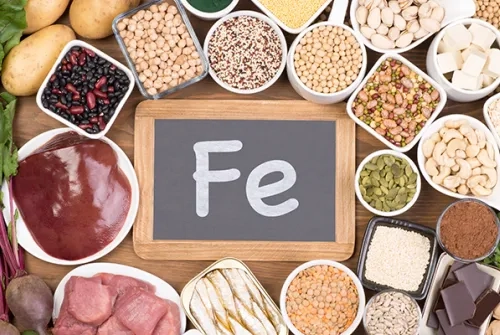Iron Deficiency is Vital
Iron deficiency is the most widespread nutritional deficiency in the world. Underlining the vital importance of iron deficiency, which is thought to be a simple problem, Pediatric Health and Diseases and Pediatric Hematology Specialist Prof. Dr. Sabri Kemahlı underlined that the deficiency must be treated.
Statistics show that about 2.5 billion people, corresponding to more than 30 percent of the world's population, have iron deficiency anemia. Pointing out that the incidence is higher in children and women, Pediatric Health and Diseases and Pediatric Hematology Specialist Prof. Dr. Sabri Kemahli said that in developing countries, 40 percent of school-age children and about half of pregnant women are iron deficient.
Iron is an important building block of some proteins in the organism, especially hemoglobin, and myoglobin. In addition, iron deficiency, which is involved in the structure of many enzymes that are involved in many metabolic events, can also cause many important health problems. Yeditepe University Koşuyolu Hospital Pediatric Hematology Specialist Prof. Dr. Sabri Kemahlı said, “Iron deficiency is the only nutritional deficiency that is also an important health problem in industrialized countries.
Iron Deficiency is Vital
Iron is one of the most important building blocks of hemoglobin, which allows oxygen to be transported from the lungs to the tissues. Prof. Dr. A. Sabri Kemahlı explained the following about other health problems that may occur due to this situation:
“The most known and important consequence of iron deficiency is that it leads to anemia. Pallor, weakness, fatigue, and loss of appetite may occur due to anemia. In severe anemia, shortness of breath, palpitations, and growth retardation may develop over time. Apart from anemia, it has been shown that resistance to infections decreases by affecting the immune system. It can also cause cognitive disorders and have consequences such as school failure. Infections do not lead to iron deficiency, but they can lead to infection anemia by affecting the use of iron.”
Unnoticed by Families
Iron deficiency and iron deficiency anemia develop over time with the depletion of iron stores in the body. For this reason, noting that children are not immediately noticed by their families, Prof. Dr. A. Sabri Kemahlı gave the following information about the process:
“In the first stage of iron deficiency, the level of ferritin, which is the storage iron, decreases, but anemia is not seen at this stage. This stage is called ’pre-latent’ iron deficiency. The later stage is called 'latent' iron deficiency. Serum iron decreases, plasma iron binding capacity and transferrin levels increase. In the last stage, in addition to these, iron deficiency anemia settles with a decrease in hemoglobin level. Anemia can only be noticed at this time. Careful examination of blood counts helps to diagnose iron deficiency. The definitive diagnosis is made with low ferritin and serum iron values."
Prof. Dr. A. Sabri Kemahlı says iron deficiency can be confused with thalassemia. “This is because the average red blood cell volume and average red blood cell hemoglobin are found to be low in both, as well as low hemoglobin. However, with a detailed story and appropriate laboratory examinations, it is easy to distinguish the two.”
Deficiency in Premature Babies is More Intense
Stating that nutritional iron deficiency is most common in children between the ages of 9-24 months, Prof. Dr. A. Sabri Kemahlı: ''Since newborns are born with some iron storage, iron administration is not required in the first weeks and months.
The fact that the absorption of iron in breast milk is higher than in cow's milk and other foods protects the baby from iron deficiency. In term babies, additional iron should be given to the baby after the first 5-6 months. This can be given with iron drops or syrups; Iron-enriched formulas can also meet this requirement. In prematurity, warehouses are lower and additional iron needs to be started earlier.”
Drawing attention to the importance of maintaining breast milk for at least 6 months in terms of iron balance, Prof. Dr. A. Sabri Kemahlı said, "The absorption of iron in cow's milk is lower than in breast milk. In addition, cow's milk is not recommended for infants up to 1 year of age because some children may have bleeding from the intestine due to cow's milk."
Iron-Rich Nutrition is Significant
After the evaluations, Yeditepe University Hospital’s Pediatric Health and Diseases, Pediatric Hematology Specialist Prof. Dr. A. Sabri Kemahlı explained the following about the treatment: “It is preferable to administer iron by mouth (drops, syrup, or tablets). However, in patients who cannot take it orally, there is also the possibility of treatment by intravenous iron administration. The way to prevent iron deficiency is to get enough iron with nutrients. Therefore, it is important to get iron-rich foods. The richest foods from iron are red meat, chicken meat, eggs, fish, shrimp, and shellfish. Although legumes and vegetables such as spinach and broccoli also contain iron, their bioavailability is lower.”
Press Coverage: cnnturk.com | haberler.com | aksam.com | yeniasir.com | mynet.com | winally.com
About
Faculty and Year of Graduation:
Ankara Üniversitesi Tıp Fakültesi (1978)
Alo Yeditepe





